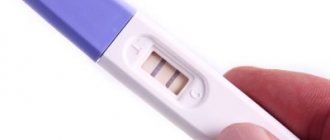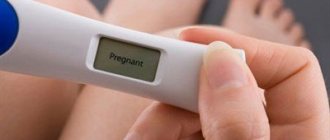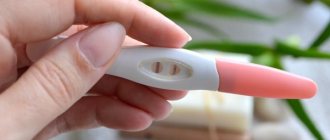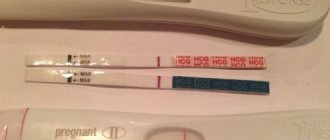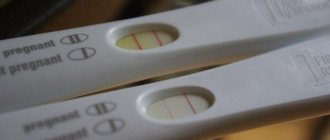When is the best time to take a pregnancy test (HCG)?
HCG is a hormone whose presence indicates pregnancy.
It becomes noticeable in the blood faster and better than in urine. Therefore, a laboratory test shows the result earlier than most pharmacy ones. Is the expected day of conception known? You can donate blood for testing a week after this date. If not, then the first day of delay will be the best reason to contact an antenatal clinic.
If the test results are inconclusive, the gynecologist will recommend donating blood again in a few days. Do you want to know the answer for sure the first time? Then it is advisable to donate blood for hCG approximately on the 3rd day of the delay. At this time, its concentration will become clearly noticeable.
Morning urine is considered optimal for donation - it is the most concentrated. Therefore, it is better to do tests immediately after waking up or at least before eating or drinking any drinks, including plain water. However, inkjet tests have increased sensitivity to hCG, so they can recognize it even in daytime or evening urine.
In individual cases, you can take the test regardless of the time of day. He is more likely to reveal the truth if the woman at that moment feels:
- pain in the chest and/or nipples;
- cramps and/or nagging pain in the lower abdomen;
- nausea, weakness, dizziness;
- a sudden strong desire to eat something specific.
These symptoms indicate an active change in hormonal levels. A test that “caught” such a moment will certainly show the truth.
Early warning signs of pregnancy
Due to the active formation of a new organism, characteristic physiological changes appear. Among them:
- Constant drowsiness, sleep lasts 9–12 hours.
- Unstable nervous state, irritability and tearfulness appear.
- There are taste preferences: you want sweet, sour, salty, unusual combinations of foods.
- Weakness, general malaise, severe fatigue.
- Nausea in the morning.
- Frequent urge to go to the toilet.
- Feeling of a foreign body inside, constant attempts to go to the toilet.
All these signs are not always the same; they differ from girl to girl. The characteristics do not 100% indicate the presence of new life, they only provide an additional hint if there is a delay.
Bleeding in the first trimester indicates pathological disorders:
- Insufficient production of progesterone provokes scanty discharge at 3 weeks. Deficiency is detected through blood tests.
- Ectopic pregnancy. Embryo development occurs in the fallopian tubes, rarely in the abdominal cavity, ovaries or cervix. Such a pregnancy can cause the death of a woman, so you should always visit a gynecologist and register with an antenatal clinic. It is impossible to distinguish such a pathology on your own.
- Molar pregnancy is the penetration of an egg incapable of life into the uterine cavity. With this type of pregnancy, implantation bleeding may appear after menstruation or at any other period of the cycle, but this does not mean that normal fertilization has occurred. Such a pregnancy is determined during the first ultrasound; it is characterized by a stop in cell division and in the picture the doctor sees the site of implantation, but there are no characteristic bubbles around the fertilized egg. The molar pregnancy ends spontaneously; if this does not happen, then a medical abortion or vacuum cleaning is performed. It may be accompanied by heavy bleeding.
- Unsuccessful placenta previa. When located close to the cervix, or when the cervix is partially covered, a small amount of blood is released and enters the vagina. Placental abruption also leads to bleeding. Both options can be dangerous for the full development of the fetus.
Any spotting after an established pregnancy may indicate a miscarriage or embryonic death, when the fetus stops developing and growing. The discharge has the consistency of mucus and bright blood, accompanied by spasmodic pain similar to contractions.
When to take a pregnancy test after conception to get an accurate result?
A pregnancy test after conception should be done at a time when the most accurate result can be obtained. Most manufacturers indicate that their testing systems have high reliability, which ranges from 97-99.8%. Thus, the risk of an error occurring is minimal. However, the procedure must be carried out on certain days. The optimal date is the date on which menstruation should begin.
If you do the test earlier, the risk of getting an erroneous result increases significantly:
- The reliability of the test is equal to 55% when the study is conducted 4 days before the start of menstruation.
- The reliability of the test is equal to 86% when the study is conducted 3 days before the start of menstruation.
- The reliability of the test is equal to 97% when the study is conducted 2 days before the start of menstruation.
- The reliability of the test is equal to 98% when the study is conducted 1 day before the start of menstruation. Thus, the risk of error at this time is already minimal and does not exceed 2%.
It is imperative to take into account the instructions from the test manufacturers that the test should be carried out on the first day of a missed period, as this guarantees the most reliable result. This statement is true, but you need to know some subtleties
The thesis is based on the fact that a woman becomes pregnant exactly in the middle of the cycle, when ovulation occurs, and menstruation should begin 14 days after conception occurs. Tests can show pregnancy only in the third week of gestation, that is, 15-16 days after fertilization. If everything happened exactly according to this scenario, then the result of the study conducted on the first day of missed menstruation will be as reliable as possible.
Now about the most important thing - conception does not always occur exactly in the middle of the cycle. Therefore, conducting research even within the time frame recommended by the manufacturer may not be informative. Practicing gynecologists are well aware of this, so they give an unequivocal recommendation - to take a pregnancy test after 1-2 weeks of a missed period. If a woman knows that sexual intercourse, which could lead to conception, occurred precisely closer to the day of ovulation, that is, towards the middle of the menstrual cycle, then the test can be performed on the 7th day of a missed period. When sexual intercourse was closer to the beginning of menstruation, and it did not occur, then the most accurate test result can be obtained two weeks after the missed period. Only in this case can we say that the test was 99.8% reliable.
For many women, this waiting period may seem too long and tedious. In this case, they need to purchase a test that is highly sensitive to hCG and conduct the study 15 days after unprotected sexual intercourse
At the same time, it is important to know on what day the intimacy occurred, which could lead to conception.
Using such calculations, you can not take into account the duration of the delay of the next menstruation
Tests are now commercially available that are highly sensitive to human chorionic gonadotropin. The number on packages with such products is 10 mIU/ml. These devices allow you to diagnose pregnancy starting from 7-10 days after intimacy. If you purchased just such a test, then you need to count 7-10 days from the date of unprotected sexual intercourse and conduct the study within this time frame. When performing the test on the 7th day from possible conception, you can get a result whose accuracy will be 88%. If the test is performed 10 days after the date of fertilization, then the risk of error is reduced to 1%.
So, it would be more correct to conduct the study not on the first day of missed menstruation, but to calculate from the date when unprotected sexual intercourse occurred. In this case, the day the next period begins does not matter
However, it is important to pay attention to the sensitivity of the device. Using conventional tests, diagnosis can be made 15 days after the date of expected conception. Tests with increased sensitivity to hCG allow the procedure to be carried out already 7-10 days after possible fertilization
Tests with increased sensitivity to hCG allow the procedure to be carried out already 7-10 days after possible fertilization.
When can pregnancy be detected?
How soon after ovulation can you determine whether a woman is pregnant or not by donating blood for hCG? As a rule, already 6-10 days after the start of ovulation you can get a completely reliable result. It is impossible to say more precisely, because there are not even 2 completely identical organisms. The urine content of human chorionic gonadotropin is two times lower. Because of this, the accuracy of the test will correspond to the accuracy of the hCG blood test result only after a few days.
To choose a test that will show the presence of pregnancy even before the day of the expected menstruation arrives, you need to pay attention to its sensitivity.
HCG levels double every 24-48 hours. At first, the indicator may be 2 mUI, after one day or a little longer - 4 mUI, and so on. For example, if the sensitivity of the test is 25 mUI, then you can independently calculate on which day after ovulation it is advisable to use it.
Knowing how pregnancy is detected, the recommendations of test manufacturers become clear.
The maximum level of hCG in a woman’s blood and urine becomes 8-10 weeks after ovulation and conception. Further, the concentration of this hormone declines.
It should be taken into account that the content of human chorionic gonadotropin is directly related to the nature of pregnancy. If a woman has multiple pregnancies, the level of this pregnancy hormone will be much higher than when conceiving one child. On the other hand, if the hCG level is too low, then this may be a harbinger of miscarriage or indicate an ectopic pregnancy.
To determine which day after ovulation you should take a pregnancy test, you need to remember three factors:
- Consider the sensitivity of the test. We discussed above how to calculate the day on which to use tests with different sensitivity levels.
- State of pregnancy. If the pregnancy is on the verge of termination or, conversely, twins are expected, then the level of hCG in both cases will be different, which also affects how soon the test can determine the fact of conception.
- Use the test strip correctly. Each type of test comes with simple instructions that must be followed for more accurate results.
To make sure that pregnancy has occurred, you should use a test on the 7-8th day of missed menstruation. In this case, the result will be most accurate. If the test does not confirm the fact of pregnancy, but there is still no period, then it is worth repeating it. If the result is negative again, some pathology may be the reason for the delay in menstruation, in which case you need to urgently visit a gynecologist.
What happens after conception?
To talk about how accurate self-diagnosis can be using modern test systems available to everyone, you need to clearly understand what exactly happens in a woman’s body after conception, because it is these changes that create the prerequisites for the emergence of so-called “interesting position” markers, which and are established through testing.
It is more correct to count not from the date of unprotected intercourse, but from ovulation. In women it occurs on average 14 days before the end of the menstrual cycle. With a cycle of 30 days, the release of the egg should be expected on day 16, and with a 28-day cycle - on day 14. The fact is that technically, conception itself is only possible during the ovulatory phase, which is limited by the lifespan of the egg (24-36 hours).
This means that it makes no difference when intercourse took place - a few days before ovulation or on the day of ovulation, conception will occur on ovulation (plus a day). Spermatozoa retain morphological and physiological characteristics for up to 3-5 days, and therefore even sexual intercourse, which took place 4 days before ovulation, may well become fateful, it’s just that conception itself will not take place on the day of sexual intercourse, but after 4 days.
On the day of ovulation, a mature egg leaves the follicle located on the surface of the reproductive gland (ovary). The follicle bubble bursts. In its place, a temporary gland begins to form, which produces progesterone. It is called the yellow body. At the same time, no less important metamorphoses occur with the germ cells of the parents: they merge, DNA information is exchanged (23 chromosomes from each parent form the genome of a new cell - the zygote). The process of formation of a zygote after the meeting of a sperm and an oocyte takes about 12 hours.
After this, the zygote begins to fragment, the number of cells inside one increases, and the slow movement of the zygote from the fallopian tube into the uterus immediately begins, since only in the uterine cavity does nature provide the most optimal conditions for the development of the offspring. The journey to the uterus takes about three days. The immobile zygote is helped in this by contractions of the muscular layer of the fallopian tubes, and the rhythmic, synchronous vibration of the villi, which abundantly cover the inner part of the oviduct.
The embryo usually appears in the uterine cavity on the 4th day after conception. By this time it consists of at least 16 cells. The blastomeres have been formed and are already differentiated into internal and external ones. The internal ones, when the time comes, will become the basis for the formation of the baby’s organs, and the external ones will become the basis of the placenta and fetal membranes. Another day later, on the fifth day after conception, the embryo acquires a new status - it becomes a blastocyst, which contains more than 30 cells.
For another 2-3 days the embryo is in a free state: it is not attached to anything, and everywhere, so to speak, it leads an autonomous existence. Only 7-9 days after conception, the most important process occurs, after which we can talk about pregnancy as a fait accompli. The embryo is implanted into the wall of the uterus.
The blastocyst sheds the zona pellucida, and the fertilized egg adheres to the endometrium. Then the villi of the outer layer begin to produce an enzyme that dissolves endometrial cells. The fertilized egg sinks deeper into the endometrial layer. The villi begin to produce a special hormone - hCG. Chorionic gonadotropin acts as a support for the corpus luteum. In non-pregnant women, 10 days after ovulation it fades away and regresses.
But if implantation has taken place, this is a signal that the need for progesterone is high, and the temporary gland continues to exist and supports the embryo with the correct hormonal background. Due to high levels of progesterone, a woman does not begin her next menstruation.
Causes of implantation bleeding
The inner surface of the uterus prepares itself every month to receive new life. During the menstrual cycle, the inner layer of the uterus, the endometrium, grows. It comes out during menstruation if the fertilized egg is not attached to the wall.
The endometrium has a loose (velvety) surface containing many capillaries designed to nourish the embryo.
In order to attach inside the body of the uterus, the fertilized egg must destroy the uppermost layer of the mucosal wall. At this moment, damage occurs to the small capillaries that make up the surface of the endometrium, and it is then that slight implantation bleeding appears.
Based on the above facts, it can be argued that the moment of implantation bleeding occurs just a week before the expected date of menstruation. If regular bleeding occurs within the specified period, pregnancy has not occurred, and if a woman has a delay, they speak of possible conception.
Such discharge in itself is not negative if the woman has no history of gynecological diseases. This is a completely normal and natural phenomenon for an adequately functioning organism, since immediately after the implantation of the egg into the uterine wall, a massive hormonal storm begins.
It is imperative to pay attention to the characteristics of the secreted mucus. The causes of implantation bleeding are not pathological at all, which means the discharge should be rare, and the color of the blood clot cannot be darker than blood during menstruation. Lighter - yes, darker, even crimson and dark brown - no.
The sensations a woman experiences during implantation bleeding are also extremely important. Especially pulling and cutting in the pubic area. The pain must be mild. The reason for this is spasm of the uterine muscles immediately after the implantation of the egg.
When keeping a diary of daily basal temperature readings, the marking curve can change significantly at the time of implantation bleeding. When fixed, the temperature rises up to 37.5C. But at the same time, already a week after successful ovulation, the temperature drops noticeably, and this is a direct sign of fertilization.
It is important to note the date of your last natural bleeding on your menstrual calendar. In a normal cycle, which ranges from 28 to 30 days, ovulation occurs on average on the 16th day. Successful fertilization of the egg will lead to its implantation into the uterine wall in a week and a half. Based on this, a woman can easily calculate the exact date of implementation.
For conception, it is better to choose a few days before and a few days after ovulation. But it is best to consult with a fertility specialist in advance, who will help determine the exact time most suitable for fertilization.
On what day after implantation will the test show pregnancy: when can the test be carried out?
\r\n\r\n (function(w, d, n, s, t) {\r\nw = w || [];\r\n w.push(function() {\r\n Ya .Context.AdvManager.render({\r\n blockId: \”RA-190225-10\”,\r\n renderTo: \”yandex_rtb_R-A-190225-10\”,\r\n horizontalAlign: false, \r\n async: true,\r\n onRender: function(data) {\r\n document.getElementsByClassName('advads-close-button').innerHTML = '0';\r\n }\r\ n });\t\t\t\t\r\n });\r\nt = d.getElementsByTagName(\”script\”);\r\ns = d.createElement(\”script\”) ;\r\n s.type = \”text\/javascript\”;\r\n s.src = \”\/\/an.yandex.ru\/system\/context.js\”;\r \n s.async = true;\r\n t.parentNode.insertBefore(s, t);\r\n })(this, this.document, \”yandexContextAsyncCallbacks\”);\r\n( window. advanced_ads_ready || jQuery( document ).ready ).call( NULL, function() {advads_items.close_functions = function() {advads.close( '#vsepr-1959585211' ); if ( can_remove_background ( 'vsepr-1959585211' ) ) { jQuery( \".advads-background\” ).remove(); }; };jQuery( '#vsepr-1959585211' ).on( 'click', '.advads-close-button', function() { var close_function = advads_items.close_functions;if ( typeof close_function === 'function' ) { close_function(); }});});”,”once_per_page”:0,”debugmode”:false,”blog_id”:1,”type”:”plain”,”tracking_enabled”:false}},”type”:”ad” ,”id”:21524,”placement_info”:{“type”:”layer”,”name”:”PopUp and Layer Ads”,”item”:”ad_21524″,”options”:{“cache-busting”: ”auto”,”ad_label”:”default”,”layer_placement”:{“trigger”:”custom”,”offset”:”500″,”delay_sec”:”0″,”effect”:”slide”,” duration”:”1″,”auto_close”:{“delay”:”5″},”close”:{“enabled”:”1″,”where”:”inside”,”side”:”right”, ”timeout”:”0″},”sticky”:{“assistant”:”bottomleft”,”position”:{“width”:”0″,”height”:”0″}}},”placement_width”: ”0″,”placement_height”:”0″},”id”:”popup-and-layer-ads”},”test_id”:NULL},”oblivki-body_29″:{“elementid”:,”ads” :{“41044”:{“id”:41044,”title”:”\u041e\u0431\u043b\u0438\u0432\u043a\u0438, body”,”expiry_date”:0,”visitors”:[],” content":"
How many days does it take for tests to determine pregnancy?
How long before you take a pregnancy test after intercourse? For the result to be reliable, time must pass. If you do a home test, that is, use urine for testing, you will have to wait about 12-14 days. If you decide to donate blood, then you can go here earlier (in 8-10 days).
There is no need to wait for a delay. If the expected date of your period falls in 15 days or more, and according to your calculations, 2 weeks have already passed since conception, you can do a test.
When purchasing a homemade test, look at the packaging. There are less or more sensitive ones. Usually on the back it is written after what period of time it is advisable to use this or that copy.
To get correct results, do everything according to the instructions:
- Use morning urine, immediately after sleep.
- Dip the strip into urine up to the mark (no less and no more).
- Evaluate the results no later than the specified time.
If the second line is there, but not clear, this may mean a short term or an ectopic pregnancy. To clarify, do a repeat test in a few days or visit an ultrasound diagnostic room.
3-4 weeks after conception, other signs will begin to appear. A woman who has already given birth will not confuse them with anything. The following symptoms will help determine successful fertilization:
- nausea;
- vomit;
- breast enlargement and tenderness;
- discomfort in the lower abdomen;
- change in taste.
If this happens and two lines appear on the test strip, hurry up to register and take all the necessary tests.
Dates
As can be seen from the physiological basis of the process, a pregnancy test is completely useless if only two or four days have passed since ovulation. At this time, the fertilized egg has not yet settled in the uterus, and therefore the level of hCG will be equally low in both pregnant and non-pregnant women. It will gradually increase in the urine only after successful attachment of the embryo, that is, during the last week of your cycle starting from day 21.
Does this mean that the test will show an accurate result on that day and after? Not at all. At first, the excess will be insignificant, just above 5 mU/ml, and the sensitivity of the tests starts at 10 units per milliliter (the most sensitive). Again, we must not forget about the individual characteristics of the process. Ovulation could be later than expected, and implantation could be delayed. Both can cause a late increase in the concentration of human chorionic gonadotropin in the blood and urine.
First of all, the level of the hormone increases in the blood. It is believed that with timely ovulation and successful implantation in the period from 7 to 9 days after conception, a blood test for hCG, which is carried out in the laboratory, can show pregnancy 4-5 days before the start of the delay. With tests, everything is different; their task is to determine the presence of the hormone in urine, and the active substance molecules get there later.
Ultrasensitive tests (with a sensitivity threshold of 10 to 15 units) can determine the content of hCG in the urine before the delay, however, provided that both ovulation and implantation took place within the average period. The most sensitive tests are best done if you really want to speed up diagnosis, 2-3 days before the delay begins.
Most modern tests have a basic sensitivity of 20 to 30 units, they are designed to diagnose based on the absence of menstruation at the expected time.
The maximum accuracy of test systems occurs in the first two weeks after the start of the delay. For a period of 4-5 days after the start of the delay, all tests, if carried out correctly, show a fairly reliable result that can be trusted.
If doubts arise, then within a week after the start of the delay you can go for an ultrasound - by this time the fertilized egg begins to be detected in the uterus, and 2-3 weeks after the start of the delay you can visit a gynecologist and undergo a standard vaginal examination - objective obstetric signs “interesting situations” begin to appear no earlier than this time.
By what signs can you identify it?
What does implantation bleeding look like? Despite the loud name, the discharge is not negative (unless the woman has gynecological diseases). It is a scanty blood “smear” with small clots and clear mucus. However, the color can vary from light red to scarlet, but brown and dark purple shades should alert a woman - this cannot be the physiological norm.
If a woman monitors her basal temperature, then during the implantation period the basal temperature can drop to 36.2 ° C, but immediately after successful implantation it will increase to 37 ° C.
Attention! Reddish discharge a few days before the expected menstruation does not always indicate the onset of an “interesting situation” - in fact, it may be the first sign of a gynecological disease.
How many days do different types of tests show pregnancy?
There are various types of devices on the modern market, including test strips, tablet tests, and inkjet electronic tests.
The optimal days to conduct a pregnancy test depend on a number of factors:
- Test sensitivity.
- Condition of a pregnant woman. For example, if there is a threat of miscarriage or an ectopic pregnancy, tests may not be informative for a long time.
- Accuracy of following instructions.
Test sensitivity and timing of pregnancy detection
Tests that have a sensitivity of 10 mIU/ml are able to detect pregnancy 7-10 days after embryo implantation. It makes no sense to conduct research earlier, since tests with greater sensitivity are not currently commercially available. Moreover, before this period, the hCG hormone in the required concentration in the urine simply will not be able to accumulate. Therefore, it is best to take a pregnancy test 10 days after possible conception. This will allow you to save money on the purchase of the device and once again not be nervous about the result obtained. Typically, tests that are ultra-sensitive will be either electronic or tablet devices.
Tests that have a sensitivity of 15 mIU/ml can detect pregnancy 10 or more days after conception has occurred. Such tests most often include inkjet devices that are not equipped with an electronic display. Although you can also find tablet tests with similar sensitivity to hCG on sale.
How to calculate ovulation
A woman's reproductive function depends on her hormonal levels. A specific substance is responsible for each part of the cycle. In the first days of the cycle, estrogen is actively produced in the body. This hormone is necessary for the formation of the endometrium. It is the inner layer of the uterus into which the fertilized egg is embedded. The more voluminous the endometrium, the better the embryo is fixed. The average duration of this period is 10–14 days. Estrogen is also responsible for the growth and development of the follicle. A follicle is a growth on the ovary that contains an egg. Thanks to this hormone, the follicle quickly increases in size. A high-quality follicle is considered to be one that measures from 21 to 23 mm.
In order for the walls of the follicle to break through and the egg to leave it, lutein-stimulating hormone comes into play. It is responsible for opening the follicle walls. This is ovulation. In rare cases, lutein-stimulating hormone increases before the follicle has time to mature. Against this background, a woman may lose ovulation or the cell may be unable to conceive.
There are other indicators by which a woman can determine the day of ovulation. Symptoms include:
- Pain in the lower abdomen;
- Changes in the properties of cervical discharge;
- Increased appetite;
- Body temperature rarely rises.
All of these symptoms may indicate that ovulation is approaching. Doctors advise determining this period by basal temperature. It accurately indicates the day of ovulation. With a sharp increase in LSG, the temperature decreases by several units. In medicine, this concept is called retraction. This will be the exact day of ovulation.
Is it necessary to wait a delay for the test after unprotected sex?
Doctors consider it premature to conduct pregnancy tests before a missed period. No one can guarantee that conception will occur exactly on the day of unprotected sexual intercourse, and not 2-3 days later. Implantation can occur after 10 days, and only then will the formation of the placenta and the production of hCG begin. Therefore, for those with a regular cycle, there is no point in relying on the date of copulation; you need to wait for a delay of at least 1 or better 2 days. Otherwise, the risk of receiving incorrect test results increases.
Will the test show results 5–7 days before the delay?
Pregnancy tests vary in sensitivity to the presence of hCG in urine.
Reagents labeled 10 MME are considered the most susceptible. They are able to detect pregnancy already on the third day after implantation. But for some women, even super-sensitive tests give incorrect results in half of the samples 5 days before the delay and in 20% of attempts when there are no more than two days left before the start of menstruation. In general, we can say that two strips on the tester before the delay, if the sensitivity of the reagent is 10 or 15 MME, confirms pregnancy. A negative result requires mandatory rechecking after a delay.
In addition to sensitivity, it is necessary to monitor the expiration date of the test. Even a super sensitive reagent will give an incorrect result if the test is expired.
A week before the cycle update, pregnancy can only be determined by hCG levels using a blood test in a laboratory.
Table: test sensitivity and permitted period for its use
| Sensitivity | 10 MME | 15 MME | 20 MME | 25 MME |
| Duration of use and features | Manufacturers indicate that ultra-sensitive tests will show 99% accuracy of the result within a week after the expected conception. But practice shows the opposite. It's better to wait at least another 3-4 days. | A significant proportion of women note that pregnancy is accurately determined by highly sensitive tests already 1–2 days before the onset of menstruation. | Before the delay, the use of such tests does not make sense; the level of hCG for them is insufficient. But 1 or 2 days of delay is the time to use tests of average sensitivity. | Tests with such sensitivity are rarely wrong because they are carried out no earlier than the third day of the delay and the hCG level is already high. Errors in the performance of these tests are possible if they are used incorrectly. |
Pregnancy determination by test after embryo transfer during IVF
Women after IVF are in a hurry to find out whether the much-desired pregnancy has occurred. But doctors advise waiting for permission from a fertility specialist to conduct the test at home. The fact is that in vitro fertilization is accompanied by the use of hormonal drugs, so the result of a regular test a week after replantation may show a positive result, and after a while - negative .
After IVF, it is recommended to donate blood and urine to the laboratory for hCG levels. The above also applies to fertilization by insemination. Although conventional tests are carried out, as with natural conception, 2 weeks after replantation, but only after approval by the attending physician.
Video: when to get tested for hCG after IVF
Pregnancy test
The first group of tests are first-generation test strips impregnated with a special reagent. It is necessary to dip the test strip into the urine for half a minute and then determine the presence or absence of pregnancy by the number of colored strips. Despite the ease of use and low cost, these tests have a significant drawback - the inaccuracy of the results. This is due to the fact that the indicator may not be saturated and give an incorrect result. The same thing can happen if you lower the test strip deeper and hold it longer than required according to the instructions.
The second group of pregnancy tests are tablet ones, which are much more reliable and, as a result, more expensive than the previous ones. The test consists of two windows, the mechanism of its action is as follows: the liquid enters the first window, spreads to the reagent layer and interacts with it. After a certain time, you see the result in the second window.
But the most effective pregnancy test available today is the jet test. Such tests contain a special layer of blue particles that firmly attach to the hormone human chorionic gonadotropin, provided that it is present in a woman’s urine (i.e., if she is pregnant). You will receive the result within a minute after use, and it will be quite reliable, but the price of such tests is significantly higher than the prices of other pregnancy tests.
The action of all these tests is based on the production of human chorionic hormone, which begins to be produced approximately seven days after pregnancy, because. it is then that the fertilized egg attaches to the wall of the uterus and begins to develop, which is manifested in the production of human chorionic gonadotropin (hCG)
When purchasing a test, it is important to pay attention to the sensitivity of the test to hCG
Let's take a pregnancy test from the senses as a basis.
Source
What does the strip react to?
The test strip is impregnated with special compounds. The reagent reacts to a substance that is produced in the female body after conception. Chorionic gonadotropin is necessary for the embryo to properly consolidate and further develop. Based on the indicators, you can judge how the fetus develops and the characteristics of pregnancy.
Normally, this substance is capable of rapid increase. The average doubling time is two days. During this time, there is a significant increase in gonadotropin. Many pregnancy tests react to an hCG of more than 25 units. This is the average sensitivity of the strips. But the modern pharmaceutical industry also offers more sensitive tests. They can react even at 10 units. If you correctly calculate the day of ovulation, you can easily determine when to take a pregnancy test.
After implantation of the fertilized egg, when will the test show
After ovulation, the stomach felt tight for about a week, then it stopped for 2-3 days, and then on Wednesday 12.03, according to all signs, implantation occurred - the lower abdomen felt a little tight and there was some slight bleeding (very scanty).
On the third day after the intended implantation, i.e. Yesterday, March 15, I did a BB test (sensitive, 10 mIU/l). Unfortunately, it didn’t show anything.
So, the question is: on what day after implantation can a test with a sensitivity of 10 show at least a weak, pale, but already clearly visible stripe? Or maybe share your examples of how it happened for you, on what day did it show? At the moment I am interested in DPI. not DPO.
The principle of operation of the test to determine pregnancy is quite simple. Two lines in it are impregnated with a reagent: the control strip appears when liquid (urine) gets on it, and the test strip only if the liquid contains the pregnancy hormone - hCG (short for its full name - human chorionic gonadotropin). This specific hormone begins to be produced after the fertilization of the female egg and its implantation into the loose wall of the uterus. After its attachment, the hCG level begins to double in some people every 24, and in others every 36 or even 48 hours
And if you pay attention to the fact that the unborn baby, as a rule, is attached to the uterus somewhere in one, but maybe almost two weeks after the onset of ovulation (and fertilization), then it becomes clear why manufacturers of tests for early detection of pregnancy It is recommended to do them only after a delay
Attachment of the fertilized egg is possible from 3 to 13 days after conception occurs. That is why some women may have a positive test even a week before their period, and for women
Source
Changes in the body
Attachment is a kind of shock to the entire female body. From the moment of conception, all biological and chemical processes in the body are quickly rebuilt. At the site of the follicle, a corpus luteum forms, which begins to produce the hormone progesterone, which affects the cessation of menstruation and further growth of the endometrium.
The immune system weakens sharply; this is necessary to preserve the life of the embryo, since the immune system may perceive the implant as a foreign dangerous neoplasm and begin to produce antibodies against it. Constant attacks of antibodies can trigger early miscarriage.
Expecting pregnancy involves maintaining a menstrual calendar. Therefore, the question often arises, on what day of the cycle does implantation bleeding occur if fertilization has occurred?
Most often, minor bleeding associated with successful fertilization appears 7–8 days before the expected menstruation, or on the first day of menstruation.
Attachment of a fertilized cell occurs regardless of the day of the cycle, but always occurs after completion of ovulation.
An approximate count of the days of the cycle looks like this:
- Normally, egg maturation occurs on the 14th day of the cycle (with a duration of 30 days).
- The finished egg is released on the 16th day.
- For fertilization, she needs from several hours to 7 days.
- The process of penetration into the uterus and attachment takes from 6 to 12 days.
Based on the results of the calculations, a conclusion should be made: the process of implantation discharge will occur from the 22nd to the 28th day of the menstrual cycle.
What affects the readings?
First of all, timing can affect the accuracy of the test system. If a woman is in a hurry and does not comply with the optimal testing times indicated above, then the likelihood of getting an unreliable result increases significantly. Even high-precision digital tests 4-5 days before the onset of a delay determine pregnancy, according to manufacturers, with only a 50% probability, but already 1-2 days before the onset of a delay, the predicted accuracy exceeds 90%
Therefore, it is very important to adhere to the deadlines, understanding that hCG cannot appear in the urine the day after conception in principle. And if it can, it’s clearly not because of pregnancy.
A woman may receive unreliable results due to the presence of neoplasms in the body, tumors that themselves produce hormones. Most often these are malignant tumors. In this case, even outside pregnancy, the level of hCG will be elevated, and tests may give a positive result.
If a woman underwent hormonal testing in the current cycle, or conception occurred as a result, you should also not count on the accuracy of the test systems. When treating infertility using these methods, the drug hCG is administered to speed up the maturation of eggs, and traces of the hormone are still detected in the urine and blood for at least 10–13 days. The test in this case can also show a second line without good reason (that is, without the fact of pregnancy as such).
One of the most common reasons for receiving false results is violation of self-diagnosis rules. Manufacturers provide each system with instructions for use. It cannot be violated. For example, strip strips cannot be immersed deeper into urine than is suggested by drawing a line with the MAX mark. After soaking, they cannot be kept for longer than the time allotted for diagnosis. If a negative test is left for half an hour, a second pale grayish stripe may appear on it, and this will not be a sign of pregnancy, but simply traces of dried applied reagent.
Jet tests must be held under stream of urine for 5-10 seconds, they are not immersed in a container with urine. Tablet tests involve instilling urine with a pipette into a special window with a test zone, while digital tests can be carried out using either the jet method or with preliminary urine collection.
The test should not be expired or faulty, and therefore the expiration dates should be examined and the integrity of the packaging should be visually assessed. You need to buy such products at a pharmacy, and not at the checkout counter of large supermarkets, because in the second case there is a higher risk of getting a faulty product, since the storage conditions in the store may not meet the manufacturer’s requirements.
Signs of late embryo implantation
There are no signs that characterize late embryo implantation - if implanted on any day of the cycle, the symptoms and sensations will be the same:
- Implantation bleeding is scanty spotting discharge from the genital tract in a volume of no more than 10-15 milliliters for three days. Its peculiarity during late invasion is the time of appearance - 10 - 11 days after the expected date of ovulation.
- Pulling pain in the lower abdomen of minimal intensity may also indicate a successful process of attachment of the embryo to the uterus.
- Low-grade body temperature - an increase in temperature to 37.1-37.2 degrees.
- General weakness, even a feeling of dizziness, may also be a concern. This symptomatology is explained by the growing level of progesterone during developing pregnancy.
HCG and late implantation: daily norms
The hCG level during late implantation is somewhat different from that during normal levels.
Estimated ovulation date
When will the test show pregnancy with late implantation?
Tests to determine pregnancy can be marked with the numbers 10, 20, 25, 30. These indicators are the average numbers of the quantitative content of hCG in the urine at which the test is able to recognize pregnancy.
If you use a test marked 30 a couple of days before your missed period, you will see only one line, since hCG during late implantation at this time is below 30. But if you use a test marked 10 at the same time, the second line will appear already clearly Thus, a pregnancy test marked 10 can tell you good news already on the 14th day after the day of expected ovulation.
Menstruation with late embryo implantation
It would seem, how can late implantation and menstruation during pregnancy be interconnected? In fact, with late implantation, the appearance of menstrual-like bleeding during an existing pregnancy is not uncommon. Menstruation may be characterized by a smaller volume and duration, but pregnancy is still prolonged in the uterine cavity. The reason for this is the later hormonal changes characteristic of pregnancy, with late implantation.
Does late implantation affect the course of pregnancy?
Delayed invasion of the embryo into the endometrium does not in any way affect the quality of the pregnancy itself and its course. The course of pregnancy can be influenced only by the location of implantation. A low-attached embryo can cause diagnoses of central, marginal placenta previa, as well as low placentation, which are fraught with an increased risk of bleeding during the gestation period.
Irina Drozdova, obstetrician-gynecologist, especially for Mirmam.pro
How do the tests work?
Pregnancy tests work like a litmus test. They signal with a second strip the presence of a special hormone in a woman’s urine - human chorionic gonadotropin, better known as hCG
To find out when the test will show an accurate result, it is important to know when and how this hormone appears in the urine
After conception, which occurs strictly during the ovulatory phase (from the moment the egg is released within 24–36 hours), a new cell of a new organism is formed - the zygote. It has its own genome, borrowed equally from two parental cells (23 chromosomes each from the paternal and maternal gametes). The zygote already 12 hours after conception begins its journey to the uterine cavity, since only in it is its further development possible.
For about three days, the zygote, fragmenting, moves along the fallopian tube. She is actively assisted by the movements of the villi on the inner surface of the oviduct. On the 4th day, the new organism appears in the uterus and remains in a state of free “floating” for another couple of days or a little more - floating in the uterine cavity.
On days 6–9 after conception, embryo implantation occurs. It sticks to the endometrium, the villi of the outer layer (chorion) begin to secrete an enzyme that dissolves endometrial cells. This way the fertilized egg gets the opportunity to create a kind of “hole” for itself into which it sinks. The villi connect to the blood vessels of the uterus. The fetus begins to receive nutrition and oxygen from the mother’s blood. And from the moment of successful implantation, the substance of interest to us, human chorionic gonadotropin, begins to enter the blood.
HCG is necessary to ensure that the corpus luteum, formed on the ovary after ovulation, continues to live and produce progesterone. Without progesterone or with a small amount of it, pregnancy cannot develop and it is terminated. In the absence of pregnancy, the corpus luteum begins to fade within 10 days after ovulation, and a few days after its work stops, menstruation begins due to a drop in progesterone.
HCG does not allow such developments. Progesterone remains high. The corpus luteum functions until the end of the first trimester, until the placenta is formed. Then the “children’s place” begins to function as a “hormone factory”, and the corpus luteum regresses. And hCG peaks towards the end of the first trimester, after which it decreases.
The hCG hormone increases every two days after implantation, approximately doubling in the blood. But in urine, on the analysis of which the action of pregnancy tests is based, the hormone begins to be detected a little later.
How the tests work
The test shows a positive result when a sufficient amount of the hormone hCG, human chorionic gonadotropin, is present in the woman’s body. When wondering on what day it is advisable to use a test strip, you need to remember that this hormone begins to be produced in the body of a pregnant woman only 6-8 days after ovulation and fertilization. It is after this time that the embryo is implanted into the wall of the uterus. The role of chorionic hormone is to block the functioning of the ovaries. Due to the increasing level of hCG, repeated pregnancy is impossible, because the hormone blocks the development of other eggs.
You can independently determine conception at an early stage by the presence of hCG in the urine. However, the result is not always reliable. Due to the fact that the concentration of the hormone in the urine does not increase so quickly,
like in blood, test readings can mislead a woman. This is especially true in cases where very little time has passed after ovulation and the day of the expected menstruation is still ahead. The solution may be a visit to the laboratory. By taking a blood test, you can find out earlier and more accurately whether conception has occurred or not. Most women decide to wait a few days and reuse test strips purchased at the pharmacy.
Can a test be wrong?
Test items of any type can produce both false positive and false negative responses.
The main mistake when using the express method is not knowing at what week the test shows pregnancy. You can exclude it by studying the instructions for the device and the theory of the fertilization process. The error may be caused by other circumstances:
- the product's shelf life has expired;
- instructions for use were not followed;
- the time of day was chosen incorrectly or the condition of a four-hour break before the next urination was not met;
- the presence of contaminants and impurities in the urine;
- a course of hormonal drugs was taken (for example, before IVF or to prevent conception), little time passed after the abortion;
- threat of miscarriage;
- there are cysts, tumors (usually oncological) of the reproductive organs;
- ectopic pregnancy.
A positive response shown by the tester suggests confirmation by more accurate medical methods. A negative answer in the absence of menstruation is also a reason to visit the doctor.
Negative test when delayed
A negative test result means that fertilization has not occurred, or the woman incorrectly takes into account the day on which the test indicates pregnancy. Before using the test product, you must carefully study the instructions for its use. For a test that detects conception using two stripes, a negative result is manifested by the appearance of one stripe. Electronic products display a minus symbol on the screen. New generations of testers, with a positive result, show the age of the fetus, and with a negative result, a favorable moment when the test will show pregnancy in the next attempt at conception.
Confirming pregnancy using a pharmacy test
Eight out of ten women surveyed say that they found out about their future motherhood by taking a test at home, bought at the nearest pharmacy, and only then going to the doctor.
The fixation of the embryo in the uterine wall for further development is called implantation. It usually occurs within 7 to 11 days after the egg and sperm unite into an embryo. From the moment of implementation, the synthesis of human gonadotropin by the chorion, the temporary protective membrane of the fetus, is triggered.
However, initially the level of human chorionic gonadotropin (hCG) is not yet sufficient to be detected by a conventional pregnancy test. Only after a week are ultrasensitive reagents able to detect the minimal presence of hCG in the urine of a pregnant woman. Just at this time, the monthly reproductive cycle is renewed and menstrual bleeding begins if pregnancy does not occur this month.
Early monitoring does not show pregnancy: it is better to wait for the delay and be absolutely sure of the result obtained
Manufacturers of all types of tests for hCG levels advise testing with their products no earlier than two days of a missed period, and this recommendation is justified. If the result is positive, then two lines will appear on the tester, one of which may be slightly lighter due to the low level of the hormone at the current gestational age.
Verification by test with non-constant cycle
Women with irregular cycles have a harder time predicting the day of ovulation. Therefore, it is advisable to focus not on your own physiology, but on the dates of unprotected sexual intercourse. Here is an approximate calculation algorithm:
- We remember the day when we had unprotected sexual intercourse. For example, July 3.
- We add 10–12 days allotted for fertilization and implantation.
- For accuracy, we add another week and conduct a pregnancy test no earlier than July 20–22.
If you have had more than one sexual intercourse, you need to repeat testing every 4-5 days, counting from the first unprotected act in this monthly cycle. It’s worth drawing conclusions by waiting for two bright stripes.
Is it possible to detect an ectopic or frozen pregnancy with a test?
The development of the fetus outside the uterus also implies the detection of hCG and a positive pregnancy test result. Due to the ectopic location, the hormone begins to be produced later and its level rises more slowly. Before the delay, most often the pregnancy will not be determined, and after that the following symptoms should alert you:
- the second band with a delay in the onset of menstruation is weakly expressed;
- the second line of a positive test does not become as bright as the first over time;
- menstruation comes with a slight delay, but during and after it the test still shows pregnancy;
- The pregnancy-confirming result soon turns negative.
If you find any of the above signs in yourself, immediately consult a doctor. The gynecologist will prescribe an ultrasound, which will confirm or refute suspected pathology.
Recently, a special test has been developed to determine the ectopic location of the fetus. It detects differences in the modification of the hCG hormone during normal gestation and pathological pregnancy with a result of up to 90% probability. The disadvantages include the possibility of conducting the test no earlier than eight days after the delay.
Stopping the development of the embryo most often occurs in the early stages of pregnancy before or shortly after the delay. You can suspect an undeveloped pregnancy at home using tests. Ultrasensitive reagents are ideal for this purpose. If initially two stripes clearly stood out on the test, and during subsequent monitoring one of them turned pale or completely disappeared, that is, the result became negative, then urgent medical consultation is needed .
At what stage does the test detect a frozen pregnancy? Everything here is individual, but the less time has passed from conception to pregnancy fading, the faster the hCG level will return to its initial levels. Stopping the synthesis of the hormone will reduce its concentration in the urine to zero, which will show a negative pregnancy test result.
In May of this year, a friend on VKontakte sent me a photo of her pregnancy test. She was confused by the pale second stripe. I advised her to urgently go to the doctor, which Yulia did. The doctor and ultrasound did not detect pregnancy or pathologies. And at the end of June, a month after the first ultrasound, concerned about the lack of menstruation, Yulia again went to the gynecologist, who diagnosed the pregnancy at 9-10 weeks, which was later confirmed by ultrasound. Why the pregnancy was not detected a month earlier remains a mystery to us, but most likely the period was too short.
If the second line on the test is present, but barely noticeable, the woman’s best decision would be to visit a gynecologist
